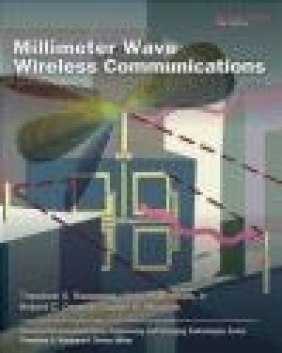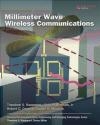Millimeter Wave Wireless Communications
Theodore Rappaport, James Murdock, Robert Heath
Millimeter Wave Wireless Communications
Theodore Rappaport, James Murdock, Robert Heath
- Producent: Prentice Hall
- Rok produkcji: 2014
- ISBN: 9780132172288
- Ilość stron: 704
- Oprawa: Twarda
Niedostępna
Opis: Millimeter Wave Wireless Communications - Theodore Rappaport, James Murdock, Robert Heath
The Definitive, Comprehensive Guide to Cutting-Edge Millimeter Wave Wireless Design "This is a great book on mmWave systems that covers many aspects of the technology targeted for beginners all the way to the advanced users. The authors are some of the most credible scholars I know of who are well respected by the industry. I highly recommend studying this book in detail." -Ali Sadri, Ph.D., Sr. Director, Intel Corporation, MCG mmWave Standards and Advanced Technologies Millimeter wave (mmWave) is today's breakthrough frontier for emerging wireless mobile cellular networks, wireless local area networks, personal area networks, and vehicular communications. In the near future, mmWave applications, devices, and networks will change our world. ' In Millimeter Wave Wireless Communications, four of the field's pioneers, including Theodore S. Rappaport, Robert W. Heath, Robert C. Daniels, and James N. Murdock, draw on their vast experience to empower engineers at all levels to succeed with mmWave. They deliver fundamental, end-to-end coverage of all aspects of future mmWave wireless communications systems. ' The authors explain new multi-Gigabit per second products and applications, mmWave signal propagation, analog and digital circuit design, mmWave antenna designs, and current and emerging wireless standards. They cover comprehensive mmWave wireless design issues for 60 GHz and other mmWave bands, from channel to antenna to receiver, introducing emerging design techniques that will be invaluable for research engineers in both industry and academia. ' Topics include * Digital communication: baseband signal/channel models, modulation, equalization, error control coding, multiple input multiple output (MIMO) principles, and hardware architectures * Radio wave propagation characteristics: indoor and outdoor channel models and beam combining * Antennas/antenna arrays, including on-chip and in-package antennas, fabrication, and packaging * Analog circuit design: mmWave transistors, fabrication, and transceiver design approaches * Baseband circuit design: multi-gigabit-per-second, high-fidelity DAC and ADC converters * Physical layer: algorithmic choices, design considerations, and impairment solutions; and how to overcome clipping, quantization, and nonlinearity * Higher-layer design: beam adaptation protocols, relaying, multimedia transmission, and multiband considerations * 60 GHz standardization: IEEE 802.15.3c for WPAN, Wireless HD, ECMA-387, IEEE 802.11ad, Wireless Gigabit Alliance (WiGig) "The most comprehensive book covering all aspects of 60 GHz/mm-Wave communication, from digital bits and signal processing all the way to devices, circuits, and electromagnetic waves. A great reference for engineers and students of mm-Wave communication." -Ali Niknejad, Berkeley Wireless Research Center (BWRC) "Due to the huge availability of spectrum in 30-100 GHz bands, millimeter wave communication will be the next frontier in wireless technology. This book is the first in-depth coverage addressing essential aspects of millimeter wave communication including channel characteristics and measurements at millimeter wave bands, antenna technology, circuits, and physical layer and medium access control design. It also has an interesting chapter on 60 GHz unlicensed band wireless standards. I found the book extremely useful and recommend it to researchers and practicing engineers who are keen on shaping the future of wireless communication. Thank you Rappaport, Heath, Daniels, and Murdock for giving us Millimeter Wave Wireless Communications." -Amitabha (Amitava) Ghosh, Head, North America Radio Systems, Nokia "I highly recommend Millimeter Wave Wireless Communications to anyone looking to broaden their knowledge in mmWave communication technology. The authors have introduced the key technologies relevant to the rapidly evolving world of wireless access communications while providing an excellent bibliography for anyone seeking to learn about specific topics in greater depth." -Bob Cutler, Principal Solutions Architect, Agilent Technologies Inc. "This timely, ambitious, and well-written book is the first to cover all aspects of millimeter wave wireless communications. The authors' interdisciplinary approach illustrates how the unique characteristics of millimeter wave hardware and signal propagation affect and can be mitigated or exploited in the physical, multiple access, and network layers of the overall system design. The authors are renowned wireless communication experts uniquely qualified to write a comprehensive book on this emerging field, which strikes the perfect balance of breadth and depth. This book is likely to become an immediate classic, as well as required reading for students, researchers, and practitioners." -Andrea Goldsmith, Stephen Harris Chair Professor, Department of Electrical Engineering, Stanford University "Mm-wave communications systems promise to alleviate the spectrum crunch and be a major part of future WLAN as well as cellular systems. The authors, leading experts in the field, have admirably succeeded in illuminating all the diverse aspects-ranging from semiconductor technology to wave propagation to MAC layer and standards-that impact the design and deployment. The book is a must-read for anybody working on this important emerging class of systems." -Professor Andy Molisch, University of Southern California, FIEEE, FAAAS, FIET, MAuAcSc "This is the first book that addresses the technologies of millimeter wave design needed to implement multi-gigabit communication links. It provides in one place the communication theory background as well as the unique characteristics of millimeter wave communication systems." -Bob Brodersen, Berkeley Wireless Research Center, Department of Electrical Engineering and Computer Science, University of California, Berkeley "With the advent of broadly addressing the millimeter wave spectrum from 30 GHz-300 GHz, new groundbreaking advances in communications are to be expected. This book provides a fantastic overview as well as in-depth background material for millimeter wave communications. It is a must-buy to be in the hands of any wireless communications engineer active in advancing technology beyond its current boundaries." -Gerhard P. Fettweis, cfAED Coordinator, HAEC Coordinator, Vodafone Chair Professor, Technische Universit(TM)t, Dresden "This timely monograph is expected to play an influential role in the definition of future generations of wireless systems by formulating a future-proof road-map..." -Professor Lajos Hanzo, FREng, FIEEE, DSc, Head of Communications, Signal Processing and Control, University of SouthamptonPreface xvii Acknowledgments xxi About the Authors xxiii Part I: Prerequisites 1 Chapter 1: Introduction 3 1.1 The Frontier: Millimeter Wave Wireless 3 1.2 A Preview of MmWave Implementation Challenges 17 1.3 Emerging Applications of MmWave Communications 19 1.4 Contributions of This Textbook 27 1.5 Outline of This Textbook 28 1.6 Symbols and Common De_nitions 31 1.7 Chapter Summary 32 Chapter 2: Wireless Communication Background 33 2.1 Introduction 33 2.2 Complex Baseband Representation 34 2.3 Digital Modulation 39 2.4 Equalization in the Time Domain 49 2.5 Equalization in the Frequency Domain 56 2.6 Error Control Coding 62 2.7 Estimation and Synchronization 72 2.8 Multiple Input Multiple Output (MIMO) Communication 81 2.9 Hardware Architectures 88 2.10 System Architecture 91 2.11 Chapter Summary 95 Part II: Fundamentals 97 Chapter 3: Radio Wave Propagation for MmWave 99 3.1 Introduction 99 3.2 Large-Scale Propagation Channel E_ects 101 3.3 Small-Scale Channel E_ects 126 3.4 Spatial Characterization of Multipath and Beam Combining 132 3.5 Angle Spread and Multipath Angle of Arrival 135 3.6 Antenna Polarization 138 3.7 Outdoor Channel Models 139 3.8 Indoor Channel Models 166 3.9 Chapter Summary 184 Chapter 4: Antennas and Arrays for MmWave Applications 187 4.1 Introduction 187 4.2 Fundamentals of On-Chip and In-Package MmWave Antennas 189 4.3 The On-Chip Antenna Environment 198 4.4 In-Package Antennas 209 4.5 Antenna Topologies for MmWave Communications 211 4.6 Techniques to Improve Gain of On-Chip Antennas 225 4.7 Adaptive Antenna Arrays | Implementations for MmWave Communications 235 4.8 Characterization of On-Chip Antenna Performance 252 4.9 Chapter Summary 257 Chapter 5: MmWave RF and Analog Devices and Circuits 259 5.1 Introduction 259 5.2 Basic Concepts for MmWave Transistors and Devices 260 5.3 S-Parameters, Z-Parameters, Y-Parameters, and ABCD-Parameters 263 5.4 Simulation, Layout, and CMOS Production of MmWave Circuits 267 5.5 Transistors and Transistor Models 273 5.6 More Advanced Models for MmWave Transistors 279 5.7 Introduction to Transmission Lines and Passives 288 5.8 Basic Transistor Con_gurations 308 5.9 Sensitivity and Link Budget Analysis for MmWave Radios 314 5.10 Important Metrics for Analog MmWave Devices 317 5.11 Analog MmWave Components 323 5.12 Consumption Factor Theory 370 5.13 Chapter Summary 382 Chapter 6: Multi-Gbps Digital Baseband Circuits 383 6.1 Introduction 383 6.2 Review of Sampling and Conversion for ADCs and DACs 384 6.3 Device Mismatches: An Inhibitor to ADCs and DACs 393 6.4 Basic Analog-to-Digital Conversion Circuitry: Comparators 394 6.5 Goals and Challenges in ADC Design 403 6.6 Encoders 407 6.7 Trends and Architectures for MmWave Wireless ADCs 409 6.8 Digital-to-Analog Converters (DACs) 421 6.9 Chapter Summary 431 Part III: MmWave Design and Applications 433 Chapter 7: MmWave Physical Layer Design and Algorithms 435 7.1 Introduction 435 7.2 Practical Transceivers 436 7.3 High-Throughput PHYs 444 7.4 PHYs for Low Complexity, High E_ciency 461 7.5 Future PHY Considerations 464 7.6 Chapter Summary 469 Chapter 8: Higher Layer Design Considerations for MmWave 471 8.1 Introduction 471 8.2 Challenges when Networking MmWave Devices 472 8.3 Beam Adaptation Protocols 481 8.4 Relaying for Coverage Extension 487 8.5 Support for Multimedia Transmission 493 8.6 Multiband Considerations 497 8.7 Performance of Cellular Networks 500 8.8 Chapter Summary 504 Chapter 9: MmWave Standardization 507 9.1 Introduction 507 9.2 60 GHz Spectrum Regulation 509 9.3 IEEE 802.15.3c 512 9.4 WirelessHD 550 9.5 ECMA-387 555 9.6 IEEE 802.11ad 562 9.7 WiGig 582 9.8 Chapter Summary 583 Bibliography 585 List of Abbreviations 653 Index 657
Szczegóły: Millimeter Wave Wireless Communications - Theodore Rappaport, James Murdock, Robert Heath
Tytuł: Millimeter Wave Wireless Communications
Autor: Theodore Rappaport, James Murdock, Robert Heath
Producent: Prentice Hall
ISBN: 9780132172288
Rok produkcji: 2014
Ilość stron: 704
Oprawa: Twarda
Waga: 1.02 kg





























